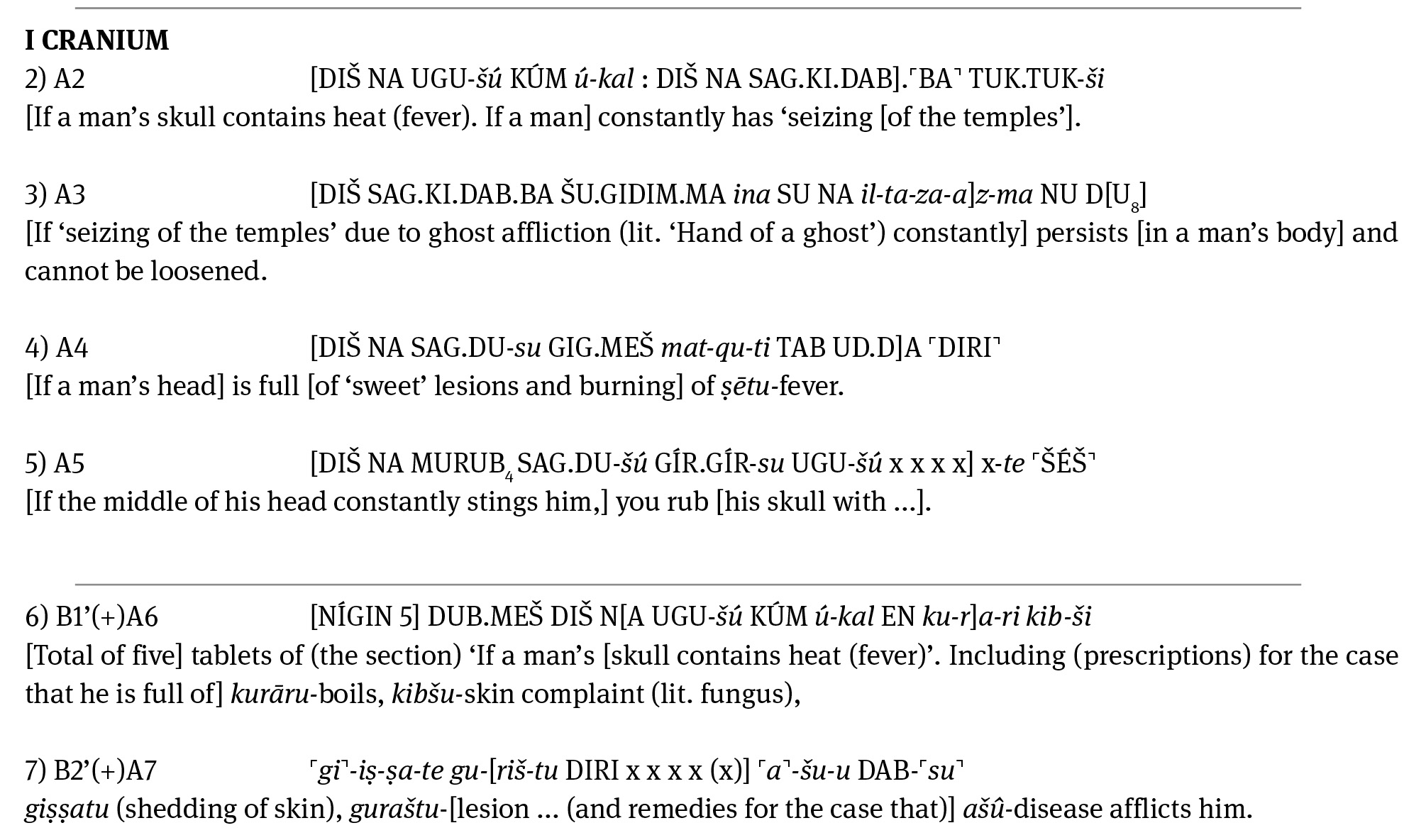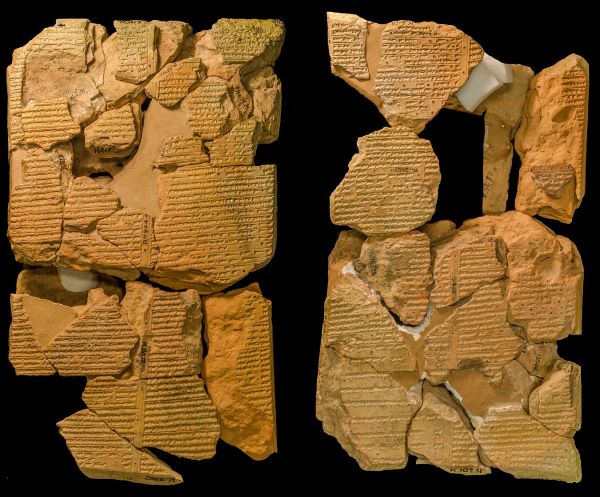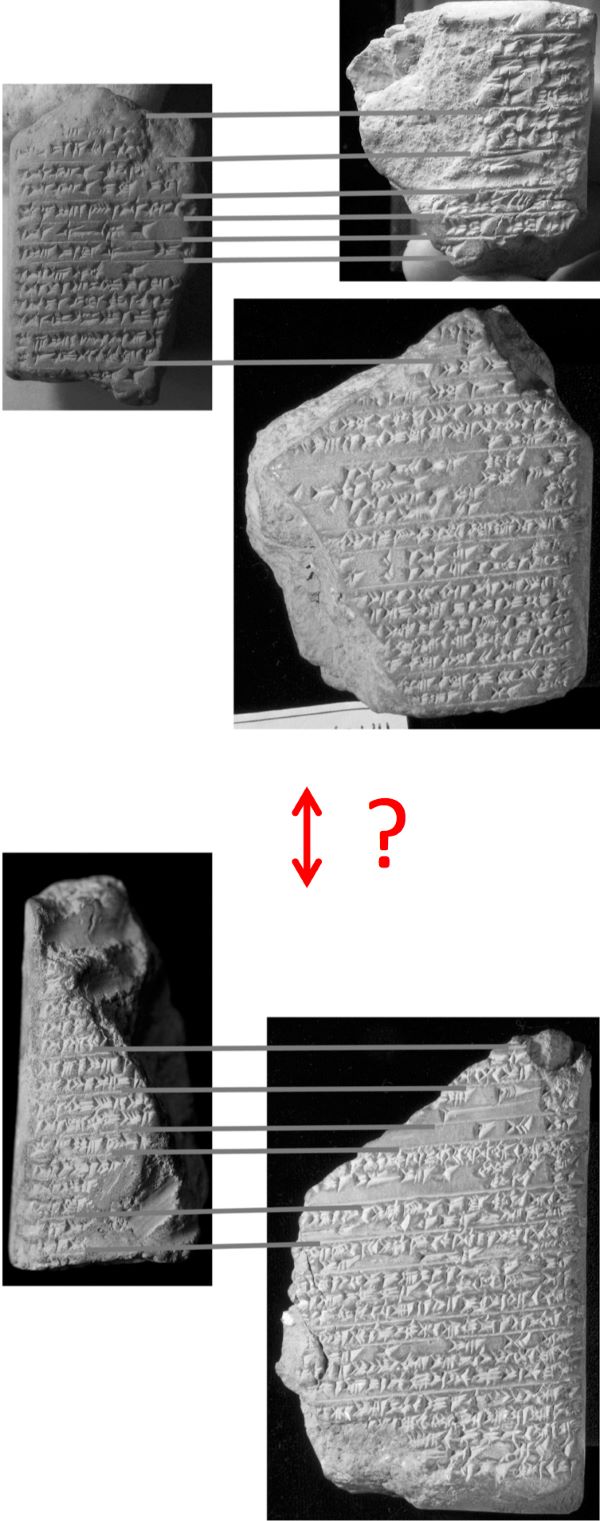NME Overview – Reconstruction
The Reconstruction of the Nineveh Medical Encyclopaedia is a product of several generations of scholars. Since the early days of studying medical texts, the British scholar Reginald Campbell Thompson recognised the existence of a structure in the medical texts from Nineveh. Later on, the Nineveh material was a central research objective of the German Assyriologist Franz Köcher. Nevertheless, the precise structure of the whole corpus and its extent was still elusive.
The game changer in the reconstruction of the Nineveh Medical Encyclopedia is a catalogue of medical and magical texts. It originates from the city Ashur, but provides important clues for the structure of the Encyclopaedia. Furthermore, the catalogue shows the existence of another big handbook with multiple treatises, which is separate from the Nineveh Medical Encyclopaedia. The reconstruction of the catalogue and its relation to the material from Nineveh has been an endeavour of many scholars. Most notably a progress has been made by the BabMed research group, headed by Markham Geller with the support of Annie Attia, Gilles Buisson and Irving Finkel.
The Ashur Medical Catalogue lists incipits of texts. An incipit is the first line of the tablet, and it is used as a designation of the whole tablet. After all incipits have been cited in the catalogue, a summary section enumerates all of them. Take a look at the very first section of the catalogue: lines 2-5 list the incipits of the first treatise (called also series or section), and line 6 is the summary wich bears the title of the treatise, which is the first incipit of the treatise. Afterwards, additional information has been cited.

Fig. 1. From the BabMed Reconstruction of the the Ashur Medical Catalogue
In reality, each incipit is represented by a single tablet, kept somewhere in an archive. Luckily, many incipits of medical texts survived on tablets, mainly from Nineveh. Let us take a look at the structure of the Nineveh material first, then go back to its relation to the Ashur Medical Catalogue. Each tablet from the Nineveh Medical Encyclopaedia has a distinct shape, and the format is kept coherent throughout. It consists of four columns, two on the obverse and two on the reverse.

Fig. 2. Obverse and Reverse of the second tablet of the oral treatise (including dental, mouth and nose problems). K 2419+ [https://www.britishmuseum.org/collection/object/W_K-2419]
Each tablet has an incipit on column one of the obverse. Then medical content follows until the end of column four of the reverse. After the medical content, another incipit is written. This is the incipit, which is to be found on the next tablet, bearing the technical designation catch-line when written on column four of the previous tablet. In this way the sequence of tablets is kept in order. After the catch-line, the enumeration of the tablet within each treatise is shown (for instance 'Tablet one (of the treatise:) If man's nose (breathing) is difficult'). Each treatise bears the name of the incipit of its first tablet. Furthermore, on the last tablet of each treatise, the catch-line for next treatise is inscribed. In this way, ancient scholars ordered the tablets within each treatise, but also the treatises within the Encyclopaedia.

Fig. 3. Schematic image of a tablet from the Nineveh Medical Encyclopaedia.
If we compare the information from Nineveh with the structure of the first part of the Ashur Medical Catalogue, we see that the whole structure of the Encyclopaedia corresponds to a great extent to the structure of the catalogue. However, since local differences and traditions shaped the written culture of Mesopotamia, there are also differences between the Ashur Medical Catalogue and the Nineveh Medical Encyclopaedia. It seems that the catalogue shows additional treatise, which is not to be found within the Encyclopaedia. Worth noting is the fact that the catalogue is very fragmentary and we are not at all certain if it overlaps with the Nineveh material completely, or if it records an additional treatise, since we do not have alignment for the distance between the fragments in the middle of the catalogue tablet. During the reconstruction work of the BabMed group, one additional treatise was assumed for convenience, which is not based on solid evidence.

Fig. 4. The fragments of the Ashur Medical Catalogue.
However, by carefully comparing the structure of the first part of the catalogue to the incipits from Nineveh, we can reconstruct the missing incipits from the Encyclopedia and vice versa. The integrity of each tablet into the Nineveh Medical Encyclopaedia is also shown by the same colophon (with several exceptions). The colophon demonstrates that the Nineveh Medical Encyclopedia and related texts are scholarly product ordered by the king himself, who wanted to be seen as an educated ruler, who acquired supreme knowledge of medicine:
'Palace of Ashurbanipal, king of the universe, king of the land of Aššur, on whom Nabû and Tašmētu have bestowed wisdom. He acquired for himself shining eyes, the pinnacle of scholarship. Of the kings who came before me, none were able to comprehend these tasks. Prescriptions (organised) from head to foot (in Akkadian: bultī ištu muhhi adi ṣupri), gleanings from extraneous materials, technical lore (and) whatever pertains to the great medical knowledge of Ninurta and Gula, I have written on tablets, checked, collated, and deposited them in the middle of my palace for my reading and recitation.'
Notably, the designation bultī ištu muhhi adi ṣupri 'prescriptions (organised) from head to foot' is the logical designation of the Encyclopaedia which is organized from head to foot, starting with treatises for the head and finishing with the feet. Notably, the same designation is to be found on the Ashur Medical Catalogue.

Fig. 5. From the BabMed Reconstruction of the the Ashur Medical Catalogue.
The summary section of the catalogue is followed by a remark that its sections (i.e. treatises) were edited a new. This remark might refer to the situation in Ashur and/or Nineveh, since both cities show different editions of the material. The same applies to the Late Babylonian and Middle Babylonian material. What we call nowadays the Niniveh Medical Encyclopaedia, was known in Akkadian as bultī ištu muhhi adi ṣupri 'prescriptions (organised) from head to foot'. The medical encyclopaedia had different recensions in different Mesopotamian cities, but the best preserved and most complete edition is the one from Nineveh fashioned in the name of the king Ashurbanipal.
Read more
Panayotov, S.V. 2018. "Notes on the Assur Medical Catalogue with Comparison to the Nineveh Medical Encyclopaedia", in Assyrian and Babylonian Scholarly Text Catalogues: Medicine, Magic and Divination, ed. U. Steinert. Die babylonisch-assyrische Medizin in Texten und Untersuchungen 9. Walter de Gruyter: 88-118
Steinert, U., Panayotov, S. V., Geller, M. J., Schmidtchen, E., and Johnson, J. C. 2018. "The Assur Medical Catalogue - Text Edition", in Assyrian and Babylonian Scholarly Text Catalogues: Medicine, Magic and Divination, ed. U. Steinert. Die babylonisch-assyrische Medizin in Texten und Untersuchungen 9. de Gruyter: 207-217
Strahil V. Panayotov
Strahil V. Panayotov, 'NME Overview – Reconstruction', The Nineveh Medical Project, The Nineveh Medical Project, Department of the Middle East, The British Museum, Great Russell Street, London WC1B 3DG, 2022 [http://oracc.museum.upenn.edu/asbp/NinMed/reconstructingnme/]